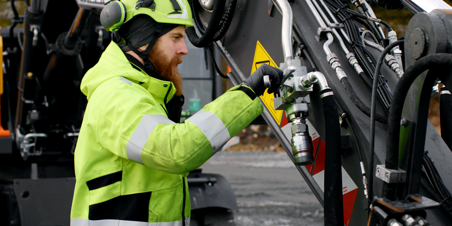Avoiding pressure loss in hydraulic systems

Learn how to avoid pressure loss in your hydraulic system by using the right quick connect coupling. Find out how to determine the right one.
A staple in virtually every hydraulic system are the fittings for connecting hoses, return hoses, suction lines, pipe, and tubes to reservoirs, accumulators, relief valves, oil pumps, check valves, control valves, hydraulic cylinders, hydraulic oil filters, calipers, pistons, displacement pumps, oil strainers, and actuators.
If connections in the hydraulic system never had to be removed, components could be hard-piped into the lines via welding, soldered, or brazing for a strong permanent hose/pipe seal. Since hydraulic systems will inevitably require disconnection of these hydraulic fittings to perform maintenance and repairs, this is rarely an option. Quick connect couplings and nipples are the preferred hydraulic fittings for connection points that require frequent disconnection. The quick connects help facilitate the connect and disconnect of hydraulic hoses and lines without the need for tools making field service and repairs as easy as possible. (without the loss of hydraulic fluid or allowing contaminants or air into the system.)
Hydraulic quick connects come in a variety of body types, like the popular ISO 16028 design. Although many of these hydraulic fittings may look very similar, the inner workings of the quick connect are far more different than they are alike. The design of the quick connect is based on the demands of specific hydraulic system parameters like pressures (accounting for potential pressure surges), temperatures inside the hydraulic system, ambient temperatures, flow rates, oil viscosity, and the general operating environment. Inside the quick connects there are different seals, plungers, and O-rings, each working in different environments/applications better than another.
The benefits of the quick connect in a hydraulic system are numerous, but there are potential negatives when a fitting is not sized correctly to match the flow rates found in the hoses, piping, and equipment found throughout the rest of the hydraulic system. With hoses and pipe, there is a direct relationship between conduit diameter (ID), length of the line, flow rates and pressure drop. When choosing a quick connect, simply matching the size of the fitting to the diameter of the hose won’t tell you the whole story and could lead to pressure drop across the entire hydraulic system. That is due in part to the different internal components mentioned above. As the design of the inner workings of a quick connect may differ, so will the way in which the hydraulic fluid contacts the walls, seals, and plungers in that fitting.
The potential size and path of the hydraulic fluid through a quick connect fitting determines the amount of energy/pressure loss. The tighter and more winding or indirect the fluid’s path, the greater potential for pressure loss. It is recommended to always account for the following specs when sourcing the right quick connect for your hydraulic machinery or system: flow rates, operating static pressure, burst pressure, inlet flow velocity, kinematic fluid viscosity, and the specific gravity of the hydraulic fluid. For some hydraulic systems, the quick connect manufacturer may need to provide additional information to help calculate/account for laminar flows, turbulent flows, friction losses, for both ideal fluids, and/or real fluid calculations.
The calculations for total pressure loss or head loss of a hydraulic system is divided into two main categories:
- Major Head Loss: Pressure loss caused by friction in straight pipes
- Minor Head Loss: Pressure loss due to friction and restrictions caused by hydraulic fittings, valves, 90s, elbows, tees, and quick connects
Despite being called “minor head loss”, the pressure loss due to restricted flows rates through hydraulic quick connects and hydraulic fittings can exceed those caused by friction losses in hoses and pipes. These minor pressure losses are usually caused by secondary flows within the fittings and valves that are caused by curvature or recirculation of the fluid. Similar to pipe friction leading to pressure loss in straight pipes, the minor head losses are roughly proportionate to the hydraulic system flow rates.
For minor head loss calculations, correctly defining the loss coefficient allows minor head loss values to be easily integrated into the Darcy-Weisback equation. Other factors that can affect the pressure loss caused by quick connects and fittings include the sizing of the component, the flow Reynolds number, and the proximity and quantity of fittings, bends, and radii relative to both upstream and downstream straight pipes and hoses. Other calculation methods may be preferred depending upon the fluid type and viscosity. These pressure loss calculation methods include the Hazen-Williams equation, Swamee-Jain formulas, the Bernoulli equation, and the Blevins method.
Undersized or otherwise flow/pressure-limiting hydraulic fittings can result in pressure losses and systems overheating. The quick connect fitting you choose may be of a lower priority, but its effects on the entire hydraulic system can be significant. Match the specs of the quick connects being installed to the system demands to help maximize flow, optimize performance and bolster a longer operating life for the hydraulic system and components.
Related Stories

Step-by-step guide: How to change the seal on CEJN TLX coupling
Using products that last is a sustainable choice for both the wallet and the planet. Rather than disposing of a product once it reaches the end of its service life, we offer a wide range of spare...

Step-by-step guide: How to install CEJN TLX on hydraulic attachments
In heavy-duty applications, the failure of quick-connect couplings often comes from high surge flows. These surges can lead to seal failures and machine damage, resulting in costly leakages and machine downtime. CEJN TLX is a super-duty coupling solution specifically designed to withstand the...

Compressed air optimisation: 5 common leak sources in compressed air systems
Compressed air systems offer a versatile and efficient power source within many industries. High reliability and a favourable cost/performance ratio have kept the compressed air solutions a top...